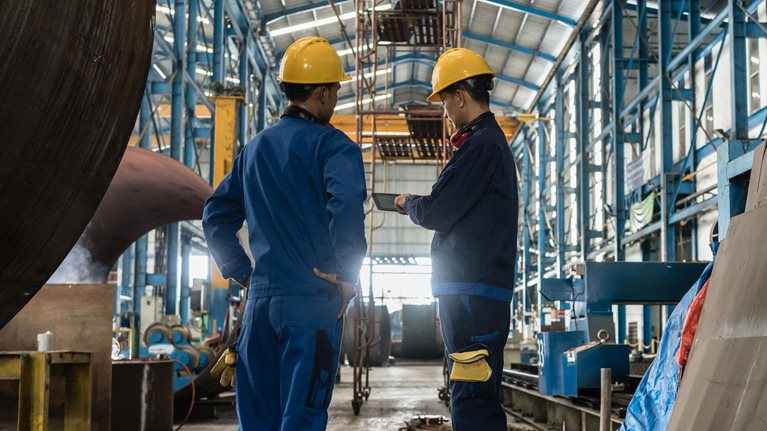Technology is changing our world. Cars that drive themselves, machines that read X-rays, algorithms that respond to customer inquiries, and the seemingly unending number of tasks we can accomplish with our mobile phones—all these manifest powerful new forms of automation and machine intelligence. Technology-driven change dates back centuries. What’s different now is the rapid pace of technical advance and the potential scale of its impact.
We are now in an era, often called the fourth industrial revolution, characterized by a technological fusion that blurs the lines between the physical, digital, and biological spheres. This technology-fueled period will give nations and companies a significant opportunity to improve their productivity and to enhance their efficiency and growth. At the same time, automation technologies will undertake some work activities currently performed by humans—a development that has sparked concern, both in the public debate and among policy makers. In Indonesia and around the world, some jobs (especially repetitive work, such as data collection) will indeed be increasingly automated. However, as with technological innovation in previous eras, new work will also be created, and many jobs will change. This in turn will have a significant impact on the skill and educational requirements of the workforce. For companies, automation will probably heighten competition and pose new organizational challenges.

How will all this play out for Indonesia? This discussion paper, which draws on the McKinsey Global Institute’s latest research, examines automation’s potential and challenges for the country. Under President Joko (“Jokowi”) Widodo, the government is determined to transform Indonesia into an Industry 4.0 economy and has chosen the ten national priorities of an integrated road map.1 Recently, it launched multiple initiatives, including some that involve skill building, to increase the pace of adoption by companies.
Overall, our research indicates that the jobs story can be a positive one in Indonesia. Even with the adoption of automation and the accompanying potential displacement of some jobs, we find that the number of net new ones created (in other words, the difference between jobs gained and jobs lost to automation) could range from four million to 23 million by 2030 (Exhibit 1). To capture the full benefit of automation’s productivity boost, Indonesia will need an integrated effort to address skills transitions. All stakeholders in the ecosystem (including educational institutions, the government, and business) will have to move quickly—and in a concerted way—to address the challenge and adapt to the needs of a changing world.
Key points of our research include these:
- Automation has the potential to raise productivity and GDP growth and to generate higher incomes for Indonesia’s workers and market opportunities for Indonesia’s companies. This improvement will be greatly needed to accelerate the country’s GDP growth, to ensure its continuing momentum, and to create jobs for the 25 million people who will enter the labor force by 2030.2
- Our research shows that although automation may displace some jobs by that year, many jobs will be added to the economy, probably leading to a net gain. In Indonesia, about 16 percent of the total hours worked could be automated by 2030 if demonstrated technologies were adopted, in a scenario that takes the midpoint of our range for the pace of automation adoption. This number of hours could be higher if adoption were faster but could drop almost to zero in the event of slow adoption. But slower adoption of technology would result in decelerating productivity growth, and thus a restrained economic growth.
- According to our scenarios, the number of jobs lost through automation could be more than compensated for by demand for new labor, especially as a result of rising incomes and increased spending on infrastructure and buildings. Automation could displace as many as 23 million jobs in Indonesia by 2030, but 27 million to 46 million new jobs could be created in the same period. This would generate a net gain of four million to 23 million jobs by 2030—including ten million people in occupations that don’t exist yet but will be created by new technologies, as well as other new types of work, in line with past trends.
- The booming gig economy, largely driven by the adoption of digital technologies and the increasing penetration of smartphones in Indonesia, is one significant example of new-job creation: companies such as Go-Jek and Grab are continuing to grow, providing job opportunities for Indonesia’s underemployed and unemployed population.3 Online commerce is another example of how new technologies are creating work: by 2022, we estimate, it could directly or indirectly support up to 26 million full-time-equivalent jobs.4
- Employment growth will probably change the mix of sectors in Indonesia’s economy as a whole. Demand for labor could rise in construction and manufacturing, accommodations and food service, education, healthcare, and retail and wholesale trade. Changing occupations and the shifting sector mix will require new skills and higher educational levels. Indonesians who have completed secondary education will probably see the largest net change in employment to 2030, but in terms of percentages the greatest opportunities will be for people with college or advanced education (Exhibit 2).
- The most sought-after skills include the ability to interact with stakeholders and apply expertise. Demand for nonroutine physical activities—such as those performed by construction workers and electricians—could also rise significantly. To adjust for this fundamental shift in skill levels, Indonesia should prepare its workforce carefully (for example, through worker training and improved school curricula).

Indonesia will need proactive strategies to remain competitive in the global and ASEAN5 marketplaces by adopting artificial intelligence (AI) and automation. All stakeholders (including policy makers, academic institutions, nongovernmental organizations, and business leaders) will have to prepare for substantial changes related to the future of work. Companies should start planning for—and transitioning into—that future right now, with long-term learning programs both for people whose jobs are changing today and those whose jobs will change in the future.
Along with measures to facilitate employment, promote innovation, and raise skill levels, policy makers could consider stepping up investments that are beneficial in themselves and will also raise demand for work, such as spending on infrastructure, education, and healthcare, as well as adaptation to climate change. Public–private partnership models can stimulate investments in these sectors. The government’s recent push for infrastructure projects across the archipelago bodes well for local job creation because these projects will need Indonesian workers. Encouraging the growth of start-ups and of small and midsize enterprises can also help to create jobs at scale and to reduce inequality. Our latest research on online commerce in Indonesia shows that e-tailing has helped to increase gender parity, financial inclusion, and expansion outside Java. Tech start-ups (such as the online marketplace Tokopedia) have created new jobs.
We hope this work contributes to a rich discussion about how to harness the benefits of technology in Indonesia.
Download Automation and the future of work in Indonesia: Jobs lost, jobs gained, jobs changed, the full report on which this article is based (PDF–11MB). The report is also available in Indonesian (PDF–4.7MB).


